Stem Cell Cheat Sheet
Posted Sun, 2007/12/16 - 20:40 by amybscher in:healthcarehacks
I thought in the midst of all this stem cell excitement in my own life and around the world, I'd give a quick explanation of what's really going on. We’ve all seen what scientists have to say, although most of them have never conducted trials outside their labs, on real patients. Here is the low-down from what I've read and seen, here in India, where they are working right before my eyes.
*Much of this information was extracted from Dr. Geeta Shroff's book, Human Embryonic Stem Cells -- A Revolution in Therapeutics, based on her experience and trials.
I know this will not answer all questions, but hope it will give the basics of the potential for use of stem cells, particularly embryonic. I feel so lucky to be in the storm of all of this, no matter how controversial it is. It's a chance I wish everyone who needed it had.
Why we need stem cells
All human bodies have the ability, to repair and regenerate to varying degrees in various organs. During a person's lifetime, the body is able to maintain a balance and as age advances, the ability becomes dampened. If the body becomes diseased, either by its own malfunction (an autoimmune disease) or viruses, bacteria, etc. (which is often the trigger for an autoimmune disease), this leads to depletion of the body's cells and often incapacitating or incurable conditions. For many common diseases, medication is given to control or Band-Aide the problem, but there is no true solution.
Once stem cells enter a person's body, they are able to supplement the missing or dwindling cells and replace or repair the malfunctioning parts of the body.
What are stem cells? Why are they important?
Stem cells are considered the body's master cells. They can differentiate into any number of types of specialized cells such as muscles, nerves, organs, bone, blood and so on. These properties make stem cells different from the body's other mature cells which are already committed to their already assigned function. For example, a skin cell can only divide and generate new skin cells. So, why are embryonic stem cells so amazing? They are able to become any type of cell because of their "plasticity" (the ability to change permanently, as opposed to elasticity, meaning to change temporarily and then revert back). This makes embryonic stem cells essential for renewing and repairing the body. They are formed at conception and specialize later to become various tissues of the growing embryo. After birth, the body retains the stem cell reserves in various organs. These reserves are finite (limited) and when depleted, the body begins to succumb to disease, disorders and aging. Stem cell therapy offers the potential to replenish the reserves and fight a wide variety of diseases and disorders.
Where do stem cells come from?
There are three major types of stem cells; embryonic, fetal and adult -- which includes cord stem cells. Each comes from different sources and has different properties.
About embryonic stem cells
When a sperm fertilizes an egg, it becomes what is known as a zygote. Many scientists view zygote as the ultimate stem cell because it can develop not only into an embryo, but also the surrounding tissues, such as the placenta. Because the zygote has the highest degree of plasticity (ability to permanently change), it is referred to as "totipotent" stem cell (read more). The zygote begins to divide 30 hours after an ovum is fertilized and by the fifth or sixth day, the cells form a blastocyst. At this point, the stem cells are less plastic and more specialized. Those on the outside develop into the placenta and other tissues that surround the fetus, while those inside, referred to as embryonic stem cells, become the cells of all the fetal organs and tissues. These stem cells can become any of the more than 200 types of cells in the body that are called "pluripotent" (read more). The embryonic stem cells do not show any immune reaction in the body because they do not have any antigenic proteins on their surface. This makes them a great candidate for autoimmune diseases.
What they are doing
-Human embryonic stem cells can divide and grow into any body part. However, in vivo conditions, their division is finite (limited). The cells follow the normal division that is inherent in an embryo. The division slows down after a period of nine months and then the functioning capacity gradually increases as it would in a growing child. Because the stem cells are finite, there are no tumors seen in transplantation. These cells do not have the ability to form a new organ. As far as the progress of embryonic stem cells, it can be said that the complete effect of cells transplanted into a patient is closely linked with the time frame of a human embryo's development. The cells continue their developmental process as per their pre-programmed time frame.
-Because they do not have antigenic properties, there is no immune reaction in the body (like there can be with other types of stem cell transplants) and immunosuppressant drugs are not required. Also, one embryo can be used to any blood type for this reason.
-They have been found to be very effective in autoimmune disorders and silencing the killer cells of the body. Adult stem cells cannot be used for autoimmune diseases because of the possible immune reaction.
-The stem cells have a "homing in" capability (that is the ability of cells to make its way to the affected tissue). They are able to find the damaged or diseased cells to begin repair.
-Stimulation and corrected of the suppressed immune system is very commonly seen. The patients become healthier and suffer fewer bouts of infection. Their body's resistance to infection increases.
-Some conditions that they have shown improvement with are autism, mental retardation, liver diseases/disorders, degenerative diseases, Alzheimer’s, Parkinson’s, multiple sclerosis, motor neuron disease/ALS, cerebral palsy, traumatic brain injuries, skin disorders, autoimmune disorders (such as lupus), genetic disorders (such as down syndrome), eye disorders, kidney disorders, musculoskeletal disorders, spinal cord injuries, and cardiac disease/disorders.
What makes Dr. Geeta Shroff different?
There are stem cell options around the world. Dr. Geeta Shroff's process is different because she has discovered a technology, which uses ONLY one human embryo to create an infinite number of stem lines, eliminating the ethical issue of destroying embryos for research and treatment. She also has created a pure human product and does not use any animal stem cells such as those found in mice or rats. And, since human embryonic stem cells don't create any immune reaction in the body, this eliminates the need for immunosuppressant drugs.
As far as I'm aware through my own research, Dr. Geeta Shroff is the only person in the world who has conducted successful clinical applications on humans in hundreds of patients suffering from incurable or terminal diseases with no adverse reactions. Dr. Geeta Shroff has filed for a patent in both India and the United States, which covers 126 countries.
Why isn't this available everywhere?
Dr. Geeta Shroff's type of work is governed by the Indian Council of Medical Research, which sets forth guidelines for stem cell research. Basically, under Indian law, doctors may treat incurable and terminally ill patients with novel procedures. Dr. Geeta Shroff is not bound by many of the regulations and politics that other countries have which is why patients are coming from all over the world to give this revolutionary treatment a chance.
*None of this information should be taken as medical advice. Please make sure to read the disclaimer located at the bottom of this blog for more information.
TAKEN FROM http://healthcarehacks.com/stem-cell-cheat-sheet
--------------------------------------------------------------------------------------------------------
| EMBRYONIC STEM-CELL THERAPY |
Laurance Johnston, Ph.D.
|
As a part of my research for this column, I’ve
traveled the world to check out innovative therapies that have the
potential to restore some function after spinal cord injury (SCI).
Continuing these efforts, I recently traveled to Delhi, India, where I
became the first American scientist to visit a unique SCI stem-cell
program.
Developed by Dr. Geeta Shroff, this program has
profound implications because it is one of the first to use human
embryonic stem cells (ESCs), supposedly the most powerful of all stem
cells (see sidebar) with huge therapeutic
possibilities.
 Because
much funding is being directed world-wide to tap into these
possibilities and potentially enormous profits, the promising
breakthroughs of a small Delhi clinic are more likely to be dismissed
than embraced by those with conflicting professional and economic
interests. However, if we learn from the lessons of history,
breakthroughs are frequently generated by innovators outside of the
system, who are not shackled by the imprisoning beliefs that often
prevail at prestigious biomedical institutions. (Photo: Drs. Ashish
Verma, Laurance Johnston, & Geeta Shroff) Because
much funding is being directed world-wide to tap into these
possibilities and potentially enormous profits, the promising
breakthroughs of a small Delhi clinic are more likely to be dismissed
than embraced by those with conflicting professional and economic
interests. However, if we learn from the lessons of history,
breakthroughs are frequently generated by innovators outside of the
system, who are not shackled by the imprisoning beliefs that often
prevail at prestigious biomedical institutions. (Photo: Drs. Ashish
Verma, Laurance Johnston, & Geeta Shroff)
Although many issues will need to be addressed
before the program obtains widespread acceptance, based on my limited
observations, I am excited about its potential and suspect it will
ultimately represent a big step toward the promised land of restored
function.
Briefly, Shroff has treated over 300 people (70
SCI) with ESCs. Often remarkable results have accrued - and especially
important given ESC’s theoretical risks, no adverse side effects have
occurred.
A Single Embryo
All cells that have been transplanted into the many
patients numerous times were derived from a single, surplus fertilized
egg from Shroff’s in-vitro-fertilization (IVF) program. Developed with
donor permission, this fertilized egg would have been disposed of under
normal circumstances.
Because Shroff is patenting her procedures, she
provided only a generalized description of cell prepa
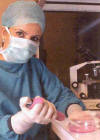 ration.
Clearly, success was facilitated by her extensive experience as a
fertility doctor working with embryonic cells. Her 70% success-rate in
making women pregnant through IVF is off the charts compared with most
other programs. Apparently, the skills she acquired in developing
healthy embryos translated well into the creation of robustly
therapeutic stem cells. Shroff emphasizes that her cells are prepared
with “Good Manufacturing Practice (GMP)” and “Good Laboratory Practice (GLP)”
quality-control standards. ration.
Clearly, success was facilitated by her extensive experience as a
fertility doctor working with embryonic cells. Her 70% success-rate in
making women pregnant through IVF is off the charts compared with most
other programs. Apparently, the skills she acquired in developing
healthy embryos translated well into the creation of robustly
therapeutic stem cells. Shroff emphasizes that her cells are prepared
with “Good Manufacturing Practice (GMP)” and “Good Laboratory Practice (GLP)”
quality-control standards.
Origins and Isolation
Basically, after an egg is fertilized, an embryo is
formed, which then splits into a two cells. In Stem Cell Now
(2006), author Christopher Scott compares the process to dividing a soap
bubble with a knife, creating two smaller bubbles within the confines of
the original. Cut again, and it becomes four bubbles or a four-cell
embryo. This division goes on, successively creating 8, 16, 32, 64,
128-cell embryo, the total volume changing little.
Between four and six days, the cells rearrange into
two layers: an outer layer that will develop into placental and amniotic
tissue and a few dozen cells called the inner-cell mass (ICM)
which turns into everything else. Now labeled a blastocyst, the embryo
is about 0.1-mm across or the size of the period at the end of this
sentence.
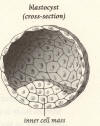
As the cells continue to develop, they increasingly
lose their omnipotent nature. After about two weeks, the ICM starts to
organize into three specific layers that become our various tissues: 1)
ectodermal layer (developing into nerve, skin, etc), 2) mesodermal
(turning into blood, muscle, bone, etc), and 3) endodermal
(differentiating into the gut, liver, pancreas, bladder, etc.).
To obtain ESCs, the ICM cells are isolated before
they start turning into these layers, and grown in culture. The
culturing technology has only recently emerged and requires
sophisticated methodology and skill. For example, scientists have had to
grow the cells on a layer of animal cells to provide nutrients and the
signals needed to keep the cells from further differentiating.
In this regard, Shroff’s breakthrough is that she
has grown ESCs without using any animal products, including these feeder
cells. By keeping the cells purely “human” in nature, she makes them
more amenable to transplantation. The cells from her “mother culture”
are further adapted or primed to create daughter cultures targeting
specific disorders. Hence, a more specialized cell line will be used to
treat individuals with SCI, stroke, diabetes, etc.
According to Shroff, the transplanted cells will
home into the tissue where they are needed. Thus, even when introduced
by more remote intravenous or intramuscular routes, the cells’
physiological affinity for the target tissue will cause them to migrate
where they are needed.
Treatment Exemption
Shroff’s ESCs use is allowed under Indian stem-cell
guidelines if the condition or disorder is considered incurable. Given
the snail-pace development of real-world stem-cell therapies in the
U.S., these are insightful guidelines. Although the U.S.s’ conservative
regulatory approach theoretically ensures safety and efficacy, it also
creates hard-to-surmount barriers that inhibit the introduction of
helpful therapies, especially for a disorder like SCI with a limited
economic market.
Pursuant to the guidelines, Shroff’s procedures
have been reviewed by an ethics committee that oversees the program. She
emphasizes to all prospective patients, who must sign an
informed-consent document, that there is no guarantee of success.
The 300 treated patients represent diverse
“incurable” disorders. In one of the more dramatic examples of the
potential power of these cells, a patient who was in a persistent
vegetative state for many years – similar to the well-known Terry
Schiavo case in the U.S. - become responsive for the first time after
ESC treatment.
Countering criticism she’s using vulnerable and
disadvantaged people as guinea pigs, Shroff notes that 30% of her
patients are physicians or have family members who are physicians. In
other words, highly educated medical professionals who appreciate
underlying issues have chosen to avail themselves of the treatment.
In addition, a number of senior government
officials have been treated and, based on their comments to me, are
delighted with the benefits. Documenting interest in her program at the
highest levels, Shroff has briefed the Indian President and Prime
Minister. Finally, showing that her program is more than just a
profit-making venture, many of her indigent patients have been treated
without charge.
Clinic
As I traveled through 13 time zones, it took nearly
two days to travel to Delhi, and jetlag’s impact was severe on sleep and
my daytime mental acuity. Because the monsoon rains had not started,
temperatures exceeded 110o F in the dusty city. Hardly
noticed by the locals, the ubiquitous din of horn honking didn’t fade
until the middle of the night. Many spoke fluent English. As in many
countries I have visited, a McDonalds was nearby - although perhaps
unique in the world of McDonald’s, no beef was served.
Shroff’s Nu Tech Mediworld clinic is located next
to Father Agnel Catholic School, and uniformed students often
enthusiastically played in the park in front of the clinic.
 Although
most patients are treated on an outpatient basis, the clinic is a 20-bed
small hospital where they can stay if required. It includes a modest
physical-rehabilitation area with therapists motivating patients to new
levels of achievement. This area was a congregating point for sharing
good news and positive developments between patients and family members. Although
most patients are treated on an outpatient basis, the clinic is a 20-bed
small hospital where they can stay if required. It includes a modest
physical-rehabilitation area with therapists motivating patients to new
levels of achievement. This area was a congregating point for sharing
good news and positive developments between patients and family members.
Overall, I was impressed with the optimistic
outlook that pervaded the clinic. In addition to patient optimism, staff
at all levels, from the doorman to physicians, projected an attitude
that they were part of something special that was helping their fellow
man and truly making a difference. Shroff and her collaborating
physician Dr. Ashish Verma have an informal, open-door policy in which
patients drop in and provide progress updates.
Treating SCI
Due to a booming economy, India has a burgeoning
SCI population. Because of the societal impact of so much SCI,
policymakers believe new approaches - such as Shroff’s stem-cell program
- are desperately needed.
Shroff has treated about 70 persons with SCI.
Although she believes that treatment would be optimal when started close
to injury, most of her patients have been injured for at least a year.
Basically, she decided not to treat the more acutely injured patients
because critics would dismiss improvements as something that would have
occurred anyway during a period in which functional gain is not
uncommon.
Patients often visit the clinic several times for a
series of transplantations. The cells are introduced through a variety
of routes, including intravenous or intramuscularly injections, and more
infrequent intrathecal transplantations directly into the spinal-cord
region. The number of transplanted cells increases over time.
During my visit, I interacted with many of Shroff’s
patients, including:
Ajit Jogi (photo), a 60-year-old Indian parliament
member and former chief minister of an Indian state, sustained a
cervical injury from a 2004 auto accident.
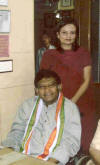 He
was unable to sit up and had difficulty breathing and even writing.
Since treatment, he can walk about 10 steps with braces, has regained
significant bowel and bladder function, has full sensation down to his
toes, and, with the renewed, very-evident energy has resumed a
politician’s busy life style. He
was unable to sit up and had difficulty breathing and even writing.
Since treatment, he can walk about 10 steps with braces, has regained
significant bowel and bladder function, has full sensation down to his
toes, and, with the renewed, very-evident energy has resumed a
politician’s busy life style.
Sonja Smith, a 45-year-old mother from Brisbane,
Australia, sustained a thoracic T11-12 injury 18 months earlier when she
attempted to stop her car from rolling down a hill with her three young
daughters inside (photo: Smith with mother & sister).
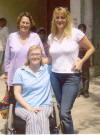 After
two months of transplantations and physical therapy, she has regained
sensation and strength in her legs and feet, can walk with the
assistance of braces and a walker, and has regained some bowel and
bladder control. After
two months of transplantations and physical therapy, she has regained
sensation and strength in her legs and feet, can walk with the
assistance of braces and a walker, and has regained some bowel and
bladder control.
Several years ago, Dr. Nalin Bhatia (photo with
wife), an Indian military physician, acquired a T4-6 injury after his
car went off a cliff, an injury aggravated by rescue workers crudely
hauling him up the cliff with ropes.
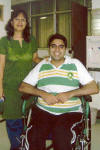 Although
Bhatia has focused his ESC-treatment on healing a bad pressure sore and
regaining bladder control, he is now able to walk with some support and
has increased muscle strength. Although
Bhatia has focused his ESC-treatment on healing a bad pressure sore and
regaining bladder control, he is now able to walk with some support and
has increased muscle strength.
Other patients less fluent in English included a
jockey, injured when his horse rolled over him; a math teacher who fell
off his house roof; and a salesman who acquired tubercular paraplegia.
They all stressed that they have regained substantial, life-enhancing
function of some sort since initiating treatment. In addition, the
salesman highlighted an often expressed, but more intangible, outcome.
Specifically, his most important benefit was a renewed, life-force
energy that coursed through him once again, a force which manifested in
his everyday outlook and activities.
All patients are carefully followed to document
progress.
Conclusion
Although many SCI stem-cell programs are emerging,
Shroff’s approach is unique because it transplants ESCs, a procedure
only in the planning stages in the U.S. Being the “mother of all stem
cells,” ESC have great potential to differentiate into therapeutically
useful tissue. The concern that they could turn into something bad has
not been realized so far in Shroff’s program. Nevertheless, people
considering any stem-cell procedure should carefully weigh, relative to
their unique situation, potential benefits that may or may not accrue
against undefined risks.
|
| TAKEN FROM http://www.healingtherapies.info/hESC.htm | |

No comments:
Post a Comment
Note: Only a member of this blog may post a comment.